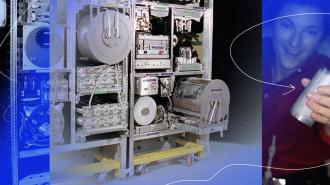A new water recycling system on the International Space Station (ISS) recovered 98% of the water used by astronauts — a huge milestone that will help NASA explore deeper into space.
Waste not: Every few months, NASA pays one of its commercial contractors to ferry cargo to the ISS, ensuring the astronauts on board have all the water, oxygen, and other supplies they need until the next delivery arrives.
These missions are not cheap, and room on the cargo vehicles is limited, so ISS astronauts go to extremes to waste nothing and recycle everything they can — while the average American uses 82 gallons of water a day, they use just one, and 93-94% of it is recycled for reuse.
“This is a very important step forward in the evolution of life support systems.”
Christopher Brown
Uncharted waters: This rate is sufficient for the ISS because the station is relatively close to Earth, and while expensive, resupply missions are logistically feasible.
NASA hopes to send astronauts farther away, though, starting with the moon and then Mars. Resupply missions to those bases would be even costlier, so it’s trying to find ways to minimize the need for them, and one of its goals has been getting the water recycling rate up to 98%.
What’s new? Thanks to a new water recycling system, recently demonstrated on the ISS, NASA has now proven it can meet that goal in microgravity.
“This is a very important step forward in the evolution of life support systems,” said Christopher Brown, part of the team that manages the ISS’s life support system.
“They are drinking water that … is cleaner than what we drink here on Earth.”
Jill Williamson
How it works: The ISS is equipped with a Urine Processor Assembly (UPA) that uses a series of filters and processes to purify the water in astronauts’ urine for reuse.
“The processing is fundamentally similar to some terrestrial water distribution systems, just done in microgravity,” said Jill Williamson, water subsystems manager for the ISS’s Environmental Control and Life Support System. “The crew is not drinking urine; they are drinking water that has been reclaimed, filtered, and cleaned such that it is cleaner than what we drink here on Earth.”
Some of the 6-7% of used water that NASA hasn’t been able to recycle on the ISS has been stuck in a “urine brine” left over after the UPA does its thing. In an attempt to get to that water, NASA sent a “brine processor” to the space station in 2021.
This system runs the urine brine through a special membrane before blowing hot air on it, which causes the water in the brine to evaporate. It can then be collected and purified by the same water recycling tech that already captures and recycles moisture in the ISS cabin air (from astronauts’ breath, sweat, etc.).
The bottom line: The less water NASA has to send to the moon or Mars along with astronauts, the more room it will have on crewed spacecraft for experiments — the kind that could yield major scientific breakthroughs that wouldn’t be possible closer to home.
“Reliable, robust regenerative systems mean the crew doesn’t have to worry about [resources] and can focus on the true intent of their mission,” said Williamson.
We’d love to hear from you! If you have a comment about this article or if you have a tip for a future Freethink story, please email us at tips@freethink.com.
